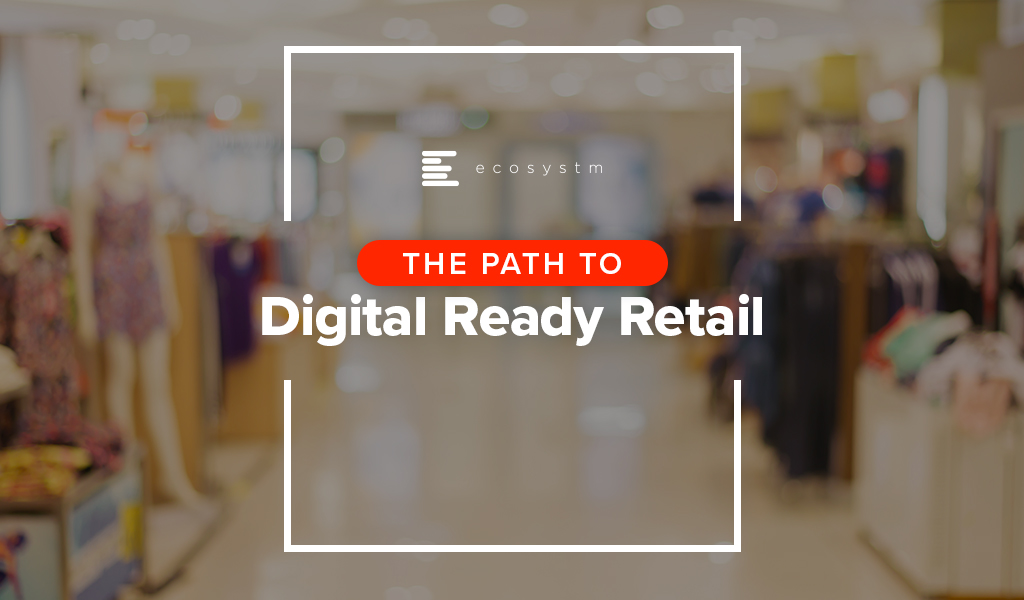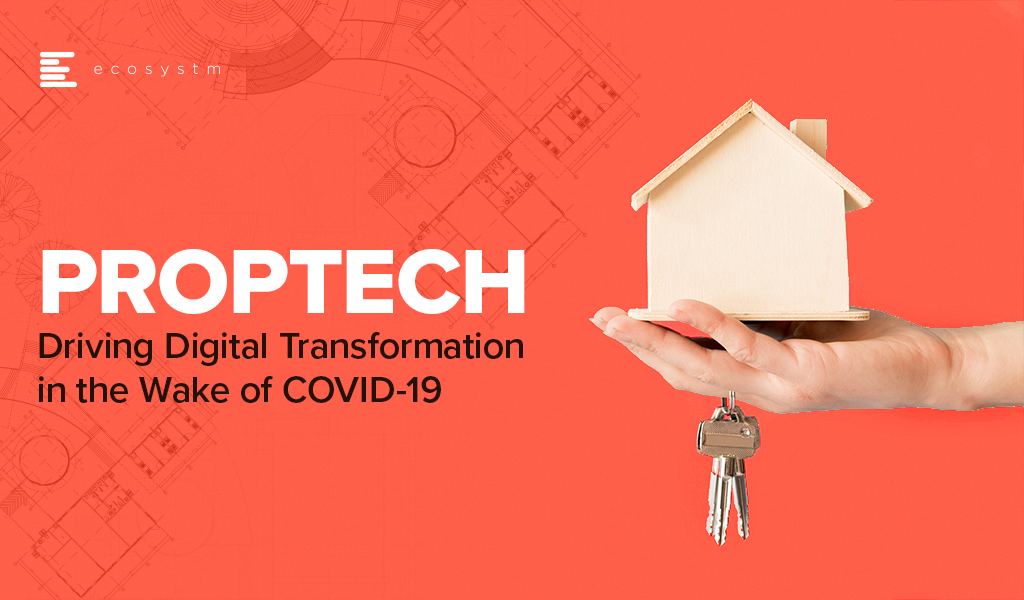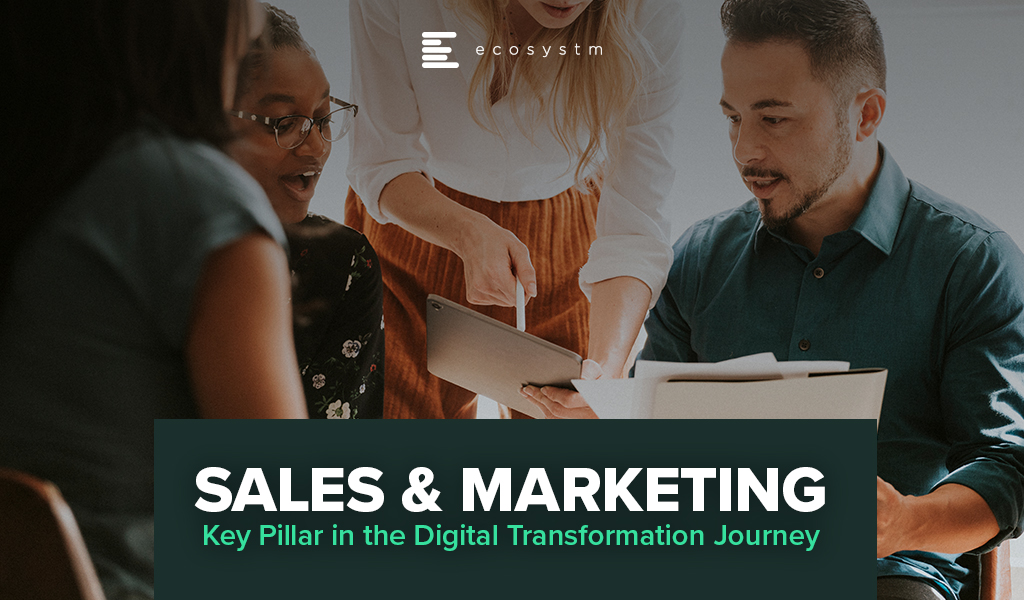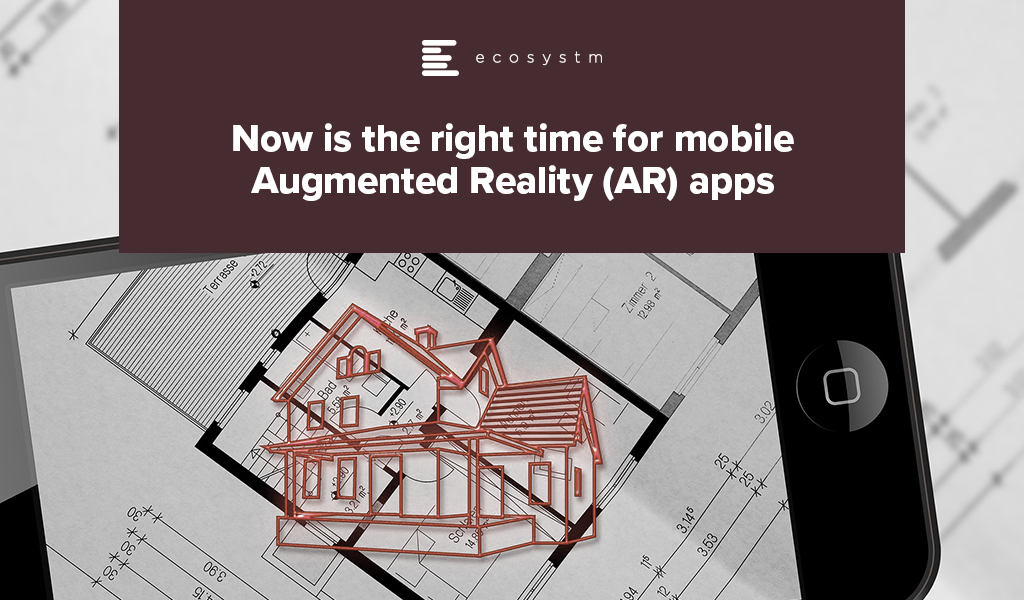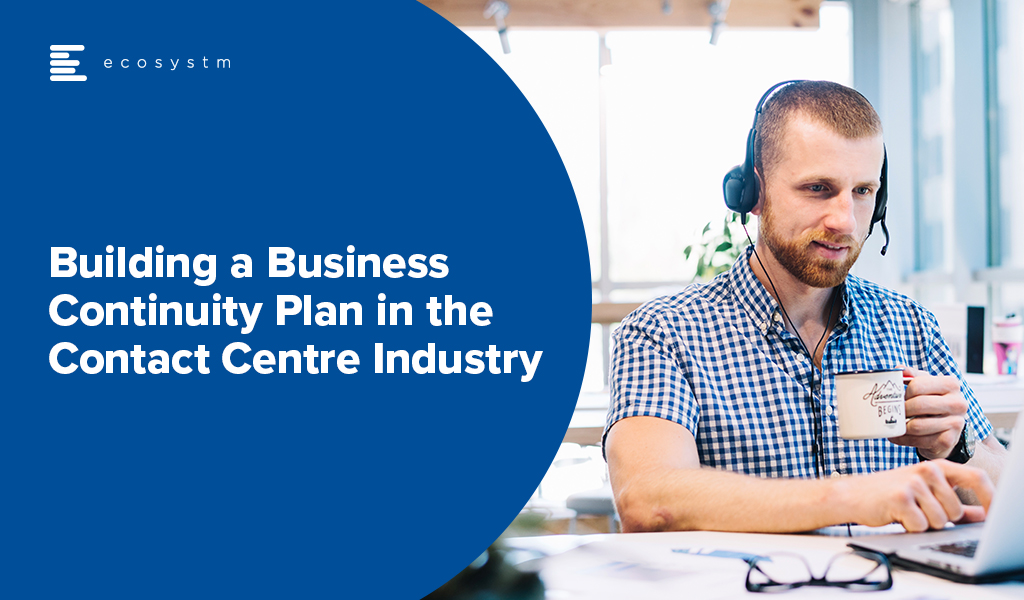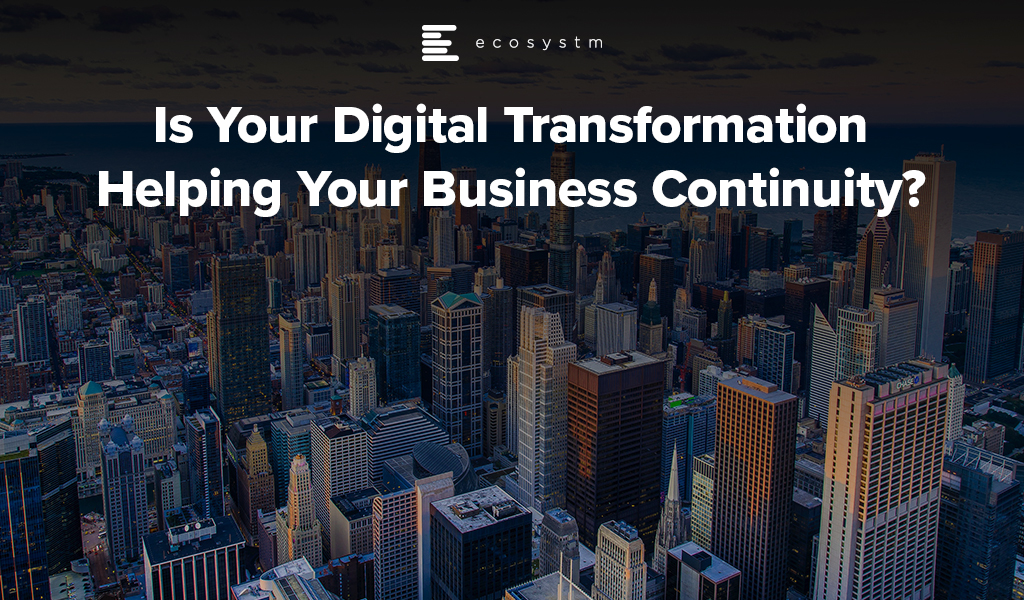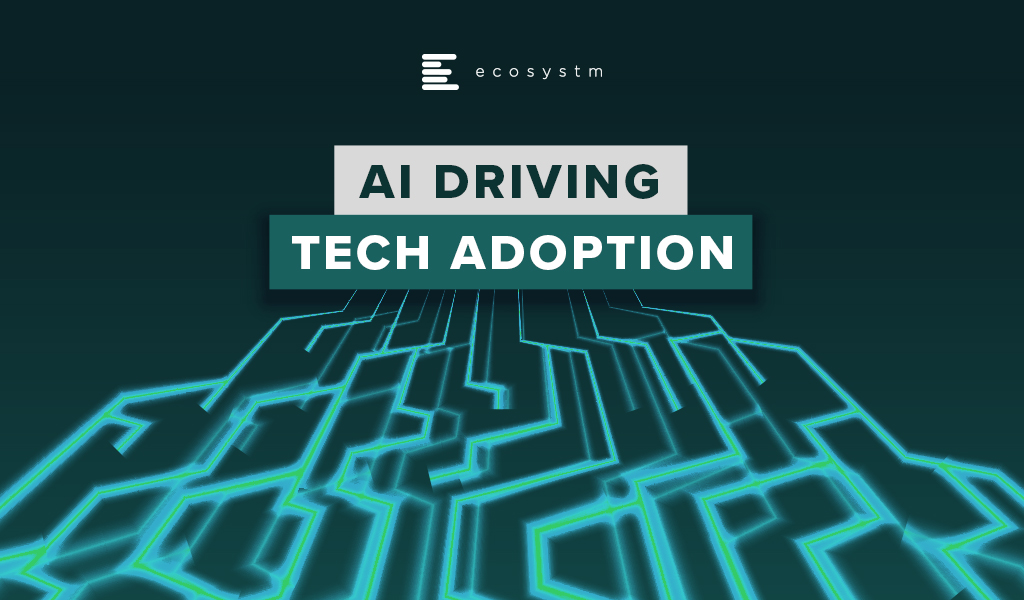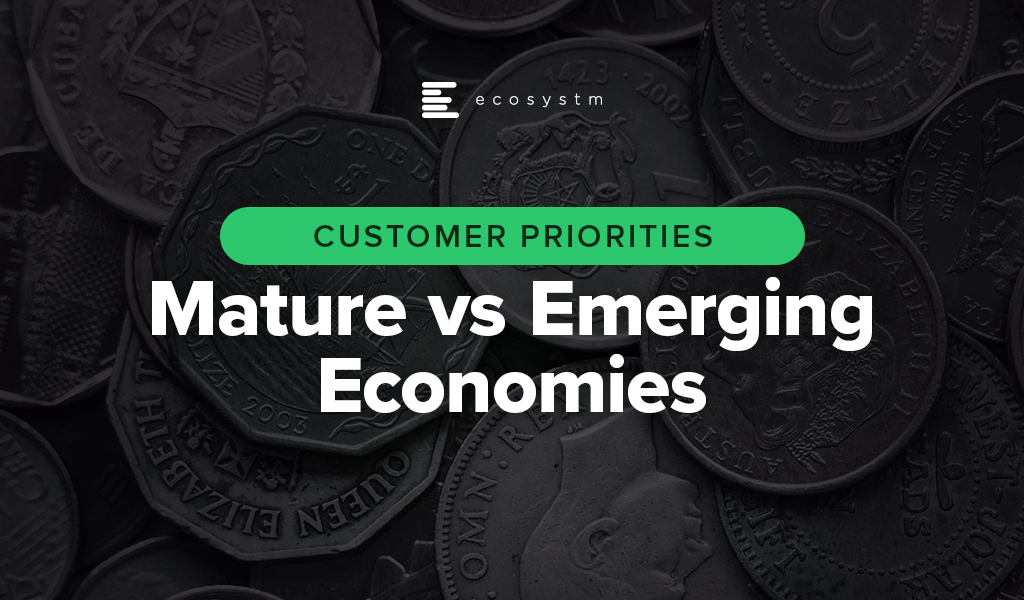2020 has seen extreme disruption – and fast. The socio-economic impact will probably outlast the pandemic, but several industries have had to transform themselves to survive during these past months and to walk the path to recovery.
Against this backdrop, the Retail industry has been impacted early due to supply chain disruptions, measures such as lockdowns and social distancing, demand spikes in certain products (and diminished demands in others) and falling margins. Moreover, it is facing changed consumer buying behaviour. In the short-term consumers are focusing on essential retail and conservation of cash. The impact does not end there – in the medium and long term, the industry will face consumers who have acquired digital habits including buying directly from home through eCommerce platforms. They will expect a degree of digitalisation from retailers that the industry is not ready to provide at the moment. This raises the question on how they should transform to adapt to the New Normal and what could be a potential game-changer for them.
Translating Business Needs into Technology Capabilities
In his report, The Path to Retail’s New Normal, Ecosystm Principal Advisor, Kaushik Ghatak says, “Satisfying their old consumers, now set in their new ways, should be the ‘mantra’ for the retailers in order to survive in the New Normal.” To be able to do so they have to evaluate what their new business requirements are and translate them into technological requirements. Though it may sound simple, it may prove to be harder than usual to identify their evolving business requirements. This is especially difficult because even before the pandemic, the Retail industry was challenged with consumers who are becoming increasingly demanding, providing enhanced customer experience (CX), offering more choices and lowering prices. The market was already extremely competitive with large retailers fighting for market consolidation and smaller and more nimble retailers trying to carve out their niche.
In the New Normal, retailers will struggle to retain and grow their customer base. They will also have to focus aggressively on cost containment. A robust risk management process will become the new reality. But above all else, they will have to innovate – in their product range as well as in their processes. These are all areas where technology can help them. This can come in the form of technology partnerships, adopting hybrid models, increased usage of technology across all channels and investing in reskilling or upskilling the technology capabilities of employees.
Re-evaluating the Supply Chain
One of the first business operation to get disrupted by the current crisis was the supply chain. Ecosystm Principal Advisor, Alea Fairchild says, “Retailers are finding themselves at the front-end of the broken supply chain in the current situation and there is an enormous gap between suppliers and buyers. Retailers will have to aim to combine inventory with local sourcing and become agile and adopt change quickly. This will highlight to them the importance of transparency of information, traceability, and information flow of goods.”
Ecosystm research shows that supply chain optimisation and demand forecasting among the top 5 business solutions that firms in Retail consider using AI for (Figure 1).

“In the New Normal, consumers are going to demand the same level of perfection that they have received and at the same cost. In order to make that possible, at the right time and at a lower cost, automation has to be implemented to improve the supply chain process, fulfill expectations and enhance visibility,” says Ghatak. “Providing differentiated CX is intimately dependent upon an aligned, flexible and efficient supply chain. Retailers will not only need to innovate at the store (physical or online) level and offer more innovative products – they will also need to have a high level of innovation in their supply chain processes.”
Digital Transformation in the Retail Industry
Ecosystm research reveals that only about 34% of global retailers had considered themselves to be digital-ready to face the challenges of the New Normal, before the pandemic. The vast majority of them admit that they still have a long way to go.
With COVID-19, the timeframes for digitalisation have imploded for most retailers. The study to evaluate the Digital Priorities in the New Normal reveals that in Asia Pacific nearly 83% of retailers have been forced to start, accelerate or refocus their Digital Transformation (DX) initiatives (Figure 2).
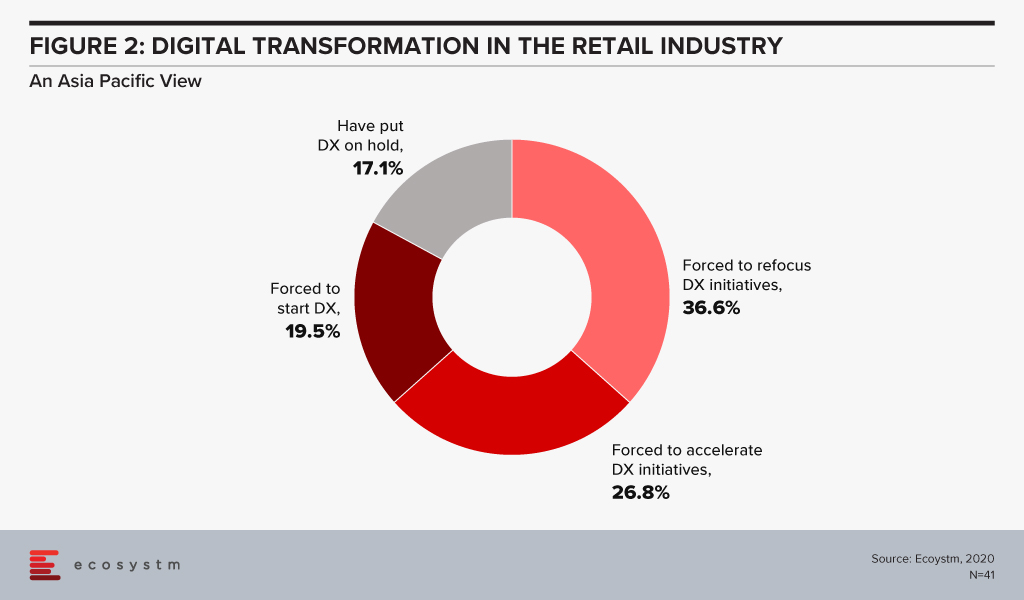
So, what technology areas will Retail see increased adoption oF?
Fairchild sees retailers adopt IoT, mobility, AI and solutions that deliver personalised experiences such as push notifications. What they are likely to do is blend different aspects of their physical and virtual environment to create a solution for customers. “To address in-store processing, hygiene, safety standards and compliance requirements, retailers will change their processes through a combination of resources, KPIs, automation, task management software and switching the information flow.”
Ghatak thinks automation has a significant role to play in improving both CX and the supply chain. “This is also an opportunity for retailers – both online and in-store – to create a solution experience where technologies such as Augment/Virtual Reality (AR/VR) can help. While retailers are adopting these technologies, with 5G rollouts, there is potential that the adoption will implode in a short time-frame.”
Those retailers that are not re-evaluating their business models and technology investments now will find themselves unprepared to handle the customer expectations when the global economy opens up.

COVID-19 is accelerating digital transformation activities across industries. Remote working is now standard practice and digital engagement is replacing face-to-face interaction. Cloud technology has become essential rather than an option, and rollouts of new technologies such as augmented reality (AR) and intelligent automation are being expedited.
One of the industries that offer great potential for technology-driven transformation is the property sector.
Many activities within the property ecosystem have remained unchanged for decades. There are several opportunities for digital engagement and automation in this sector, ranging from the use of robots in construction to the ‘uberisation’ of the residential property customer journey.
The processes associated with buying or renting property remain cumbersome and complex for customers. Indeed, customers engage with many different organisations throughout their residential property lifecycles. When compared to some other industries, the customer experience can be poor. Components of the journey – such as property search – offer some great experiences but other parts such as exchanging contracts can rarely be described as positive customer experiences.
Although AR and virtual reality (VR) technologies can facilitate property inspection, most inspections are still undertaken on-premise, together with a real estate agent. Contract exchanges often involve interactions with legal professionals in-person. Securing a mortgage or a rental agreement also typically requires face-to-face interaction. Deposits commonly necessitate the physical presentation of a cheque.
The Uberisation of the Property Sector
So, in the residential sector, there are clear opportunities for start-ups and property search platforms to offer greatly enhanced customer experiences. The COVID-19 crisis will speed up the rate at which digital technologies are used to automate activities throughout the residential property customer journey and to engage customers digitally.
Property search platforms such as Singapore-based PropertyGuru, have been creating innovative ways of engaging customers and extending their range of services, for many years. For PropertyGuru, its news features, mortgage calculator, and ability to search for investment properties overseas, have enabled it to offer customers more value from its platform. Its PropertyGuru Lens feature uses AR and artificial intelligence (AI) to give customers a more immersive and improved experience. In common with other real estate platforms, it offers AR and VR tools for inspections.
Today’s crisis creates opportunities for platforms such as ProperyGuru to engage customers throughout their journey. It can potentially transform the residential property business, by becoming an Uber-style platform for agents, movers, shippers, storage companies, interior designers, renovation firms and all other stakeholders within the residential property ecosystem. Subject to regulation, it could also act as a mortgage broker and an agency for the exchange of contracts. In other words, it could ‘own’ the customer journey and act as a platform for all services associated with residential property. From the customer perspective, such a platform would be a welcome way of enhancing the experience associated with buying, renting, maintaining, improving, managing, and selling residential property.
IoT and the Commercial Property Sector
From a commercial property perspective, the COVID-19 crisis can also be expected to accelerate the digitalisation of many activities associated with the construction, maintenance, and management of buildings.
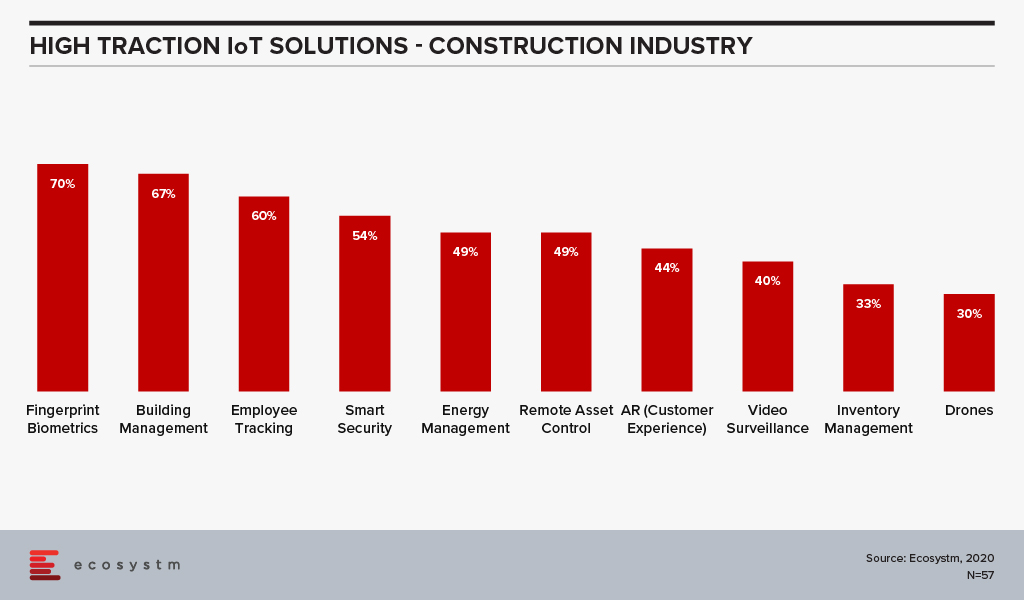
According to the findings of the Ecosystm IoT Study, the Construction industry is evaluating several technology solutions that are expected to benefit the industry (Figure 1).
While the industry views these solutions as beneficial, the adoption has so far been low. This will change. Drones have been used to inspect the outside of tall buildings for several years, but this is not yet standard practice. Structural inspections and maintenance of buildings will be automated at a much faster rate post COVID-19. IoT technology will be used for building management. Using IoT technology for the predictive maintenance and management of lighting, climate control, elevators, security, windows and doors will become standard as firms seek to reduce human interactions. Technology that measures footfall, manages safe distancing, takes peoples’ temperatures and identifies those who enter and leave buildings will be introduced, as organisations guard against disease clusters developing within or around their premises.
In essence, the COVID-19 crisis will act as a catalyst for the digital transformation of the property sector. There is a huge opportunity to create new business models not least by offering customers a digital platform on which all of their property-related needs can be addressed. For the commercial property sector, a similar platform can be offered. Additionally, many core activities ranging from construction to building management will be automated, fully leveraging robot, AI and IoT technologies.

Organisations across all industries must leverage technology to transform and be part of the digital economy. This has significantly accelerated in the last couple of months as they are forced to transform to survive in these difficult times. Digital Transformation (DX) is no longer a hype, but organisations will continue to struggle to align their transformation priorities to deliver real business impact. From experience, the needs of the Sales & Marketing teams are often lost in the midst of competing for organisational priorities with process optimisation emerging as the first choice.
Why is it necessary for Sales & Marketing to transform?
Organisations’ Business Priorities
The primary reason is that organisations are responding to market pressure and putting customer experience (CX) ahead of even revenue growth as their key business priority (Figure 1).
It stands to reason that if organisations have the improvement of CX and revenue growth as their top priorities, they should involve functions that have higher customer interactions in their DX initiatives. Unfortunately, this is not often the case, even though organisations are inherently aware that their customer base is evolving. Sales & Marketing is all about meeting customer needs, solving their problems and giving them a great experience. In today’s competitive world, an organisation will fail without a customer focus.
The Evolving Consumer
Customers are challenging organisations to change the way they deliver a great experience. Take the growth of smartphone use as an example. Almost any activity will have some element of the smartphone being involved – researching a product, using an app, looking at information posted on a social media platform, engaging with friends to get opinions. This is driving organisations to respond with a ‘Mobile First’ policy and a digital nimbleness which they must equip their Sales & Marketing teams to handle.
Social and digital platforms are also forcing marketers to evolve the way they grab their customers’ attention. Customer service has tremendously benefited from the drive to go digital. It can impact every Sales & Marketing operation, beginning from first consumer touchpoint, all the way through the customer journey, post-purchase engagement and even in predicting issues to prevent them. This requires a huge degree of automation in the Sales & Marketing processes.
Emerging Ecosystems
As the digital world becomes a reality for consumers, the traditional supplier-vendor-channel model might soon become redundant. This is the age of ‘influencers’ – bloggers, customers, vendors, and paid endorsements – and an ever-evolving ecosystem. Engagement with the digital community can be a game-changer for many organisations. Such strong digital community ecosystems are hard to include in the traditional marketing model.
What should Sales & Marketing do to transform successfully?
Ecosystm Principal Advisor, Niloy Mukherjee, has some real-world advice for organisations that are looking to transform their Sales & Marketing practices.
Align with your Basic Strategy
Evaluate your key business goals and work out the changes that are required to achieve those. These changes might be so small and incremental that it may not even appear to be a ‘transformation’. Keeping an eye on the goals, will ensure that you do not invest in areas that do not necessarily need changing. It will also ensure that you simply do not replace an existing process with a new one, without first working out how that change will impact your organisation.
Think beyond features – to the Benefits
Technology investments often end up being the shiny new toy. Decision-makers in organisations may get attracted to snazzy devices and application features – and lose sight of evaluating the true benefits of the technology. For instance, the sales rep selling in-store would have a very good idea of what sells and how much stock to carry. There may be no incremental benefit in equipping the rep with an app that provides real-time sales analytics and inventory data. So, the app gets relegated to being just a feature with no real benefits. On the other hand, a field sales rep might find it extremely useful, especially in sectors that are prone to unpredictable spikes in demand.
Be ready to Invest in the change
You have evaluated the changes that your organisation needs, you have identified the technologies that can truly benefit your organisation – you must be ready to invest in that change. This is not only about financial investments – you have to invest time and in people. This requires your organisation to think of the RoI, again not only in terms of finances but also in terms of effort. Be aware that your biggest challenge in implementing the required change might be people – so invest in making them less resistant and more welcoming of the change.
There will be distractions galore in your transformation journey – emerging tech areas, solutions that seem to be working for your competitors and so on. Mukherjee proposes a simple thumb rule, “If it fits the strategy and looks feasible go with it; if it is outside the agreed strategy then think long and hard, and then turn it down – or change the strategy!”
Click here to download the full report ?

Scenario one: I have two friends in their late 50s, home on quarantine in the UK. As they need exercise, it is a wonderful time for them to update their old Nordic cross-track system. They eyeballed the website, thought it was the same footprint and weight as the existing one that was upstairs in their home and placed the order.
The delivery man left the 100kg+ package next to their doorstep doing social distancing properly. Not only is it not portable but had to be constructed piece by piece in their living room as they could not carry the bigger parts up the stairs.
Scenario two: Friends who are seasoned travelers with wandering feet want to go travelling once quarantine is over. They want to go to a resort in Cabo San Lucas, but they cannot find a good travelogue of experiences and dining options at the resort other than Yelp or TripAdvisor with very two-dimensional reviews.
As you can see from the recent article in The Times, a number of people are taking this time to plan where they want to go.
These are two examples of why now is the time for implementing a mobile AR app solution.
Invest Now in AR
At this moment you have a captive audience with more time on their hands than normal, and eager to consume. And many are building home offices or making medium-term travel plans and need more than what a flat website experience offers them.
So now is the time for investment in augmented reality mobile apps. How many firms are seeing this and what has been their experience?
Based on the tech buyer feedback from the ongoing global Ecosystm Mobility Study:
- Only about 1% of organisations have a mobile AR app, with another 5% evaluating it in 2020
- Average current implementations tend to look at a CapEx spend of about 45% – however, those who are planning to implement a mobile AR app expect to pay about 53% CapEx
- 7 out of 10 organisations say that implementation cost was less than US$10,000
- 8 out of 10 organisations say the implementation took more than 3 months (with 4 out of 10 saying it took 6 months to a year)
Extending to digital experience
Traditional print publications already understand the need to extend the digital experience for readers. The New York Times has been rethinking how it can connect the print and digital reading experiences. In partnership with Google Lens, smartphone users can access additional information online that corresponds to the print version of their New York Times Magazine. In the next three months, all New York Times Magazines will have some features that are Google Lens-enabled.
It is a great moment for both product and experiential marketers to be taking advantage of time at home by using an augmented reality mobile apps to bring the product into the home or home office, and the experience to life in your own kitchen or living room. And in return, getting great real-time feedback on what customers are looking for.
We’ve all seen the demo of the IKEA mobile app on where to place your couch. But product location placement is missing from any number of key categories. This is including computer monitors and TVs, as well as office furniture and professional lighting equipment for that better quality of video con-call.
What other kinds of market engagement uses are there?
Packaging links to AR
Create custom “trackers”, either printed or on-screen icons, when scanned with a white labeled app to trigger a video or a 3D model overlaid on the real world. Design a scannable package with customer experience in mind and include tracking engagement and sharing links. Set up an AR trigger based on a packaging feature and invite the customer to scan the same with their phones. Note that you can also add AR as a feature into your existing Android or IOS app. Dependency on dedicated app or app plug-ins is gone. Brands can now leverage the potential offered by augmented reality using just a URL. Users can open the URL in any mobile-based browser and augment interactive digital content on their camera view.
Reverse product placement
As the opposite of how locations tried to link to Pokemon Go, your product could be an element in a popular Augmented Reality game. It could attract new customers who would link to more AR provided information on the product.
Weather as a factor
These types of apps can show what the weather may be like at a location. Possible app usage for showing residential real estate. It could show impact in a flood zone as to how much water may enter the area. Or it can warn people on urgent physical issues.
Practical advice before consumption
Too much time on your hands and hate your hair? See what the color will look like before you make a hair color mistake. Perhaps more AI than AR. Note that right now you may be able to buy hair dye. But you will likely not have access to the person who can repair any mistakes you make at this point. Think carefully.
Final Thoughts
Now is this time to engage bored consumers and eager potential users. Take advantage of what this uncertain time can bring to your firm. Use Augmented Reality as a benefit to create value and content stickiness for your customers.
Agents are the most valuable assets in a contact centre. In the current environment, the biggest threat is agents getting infected, causing the closure of contact centres for weeks or possibly even longer. We are already seeing the impact of that with offices being shut, students not going to school and industry gatherings and events being put on hold or cancelled. So having a business continuity plan (BCP) is critical. The BCP should include ways to continue to engage with customers.
The contact centre manages live interactions. Every second there are voice calls coming in, emails received and self-service tools being accessed. It is important to have multiple backup plans – both from a people and a technology perspective – to keep operations running effectively, without calls being put on hold too long or with other channels going unanswered. Contact centres battle with these challenges every day and the situation will get far more serious with the ongoing changes we are witnessing.
Some important considerations include:
Having a backup plan allowing agents working from home
More contact centres today are gearing up to agents working from home, but the process is not an easy one. To begin with, the initial set up includes having the right connectivity and a reliable network. Ensuring that the agent has the right working environment with minimal distraction is crucial. A good quality headset can help. A poor-quality headset will only create unwanted problems with understanding customer issues and handling them. Other concerns include security, tracking how data is being handled, agent under-performance and safety of the agents from an operational and health perspective. Measures such as listening to call recordings and storing them centrally are growing in importance. Multi-factor authentication and analytics using agent logs are some measures that can be put in place.
While there are lots of tools and technologies to monitor and check on agents, the key for home-based agents will be trust. Some outsourced contact centre providers that have been using home-based agents for years have stated that having trust and not micromanaging the agents, is essential for the model to work. Some contact centres have also deployed a BYOD policy for home-based agents assuming the right security, device management, application management and authentication measures are in place.
Organisations should also consider actively recruiting additional home-based agents. These agents could be retirees, currently unemployed or people with mobility issues who prefer to work from home.
Given the difference in the working environment, the metrics used to measure agent performance needs to be modified to be more realistic and fair to both agents and organisations.
Employing home-based agents will drive employment amidst challenges in the economy. Ecosystm research finds that more than a third of organisations do not have provisions for agents working remotely (Figure 1).
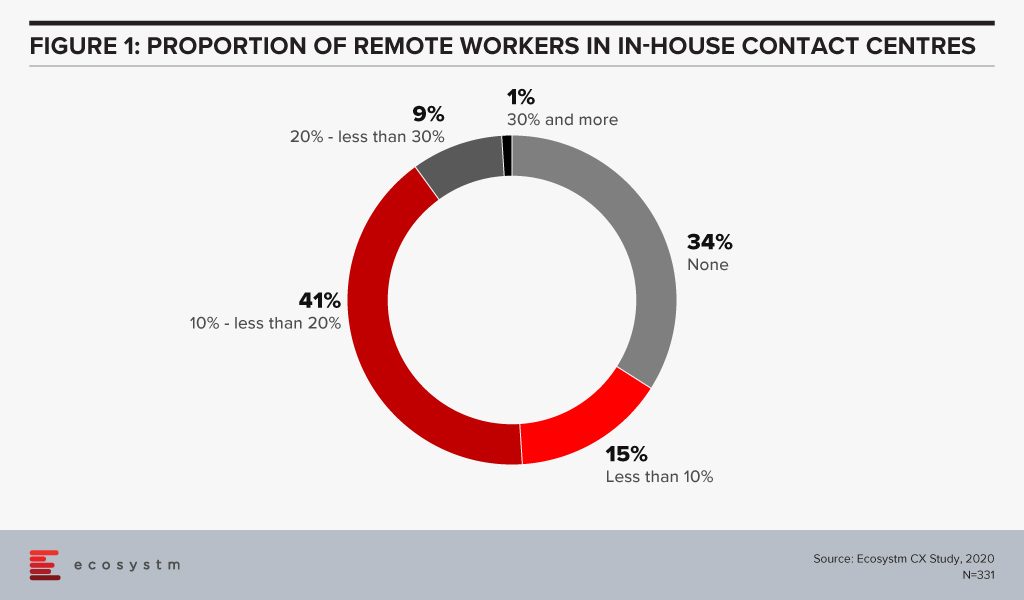
For a long time, the industry has talked about the rise of home-based agents and while it has received positive momentum, it has never really taken off in a big way. This time it will.
Managing spikes in voice and non-voice calls
In industries such as healthcare and airlines, call volumes are exceeding normal volumes. Having the ability to deflect the calls to other non-voice channels will be important. It might need the Interactive Voice Response (IVR) scripts to be changed from time to time to manage the flow of the calls. This is when cloud architecture becomes important. The cloud model can be used to make changes to call workflows easily. The sudden peaks will also require changing the channels easily and without intervention from IT. This is where the agility of cloud comes in as it allows changes and additions – for example when 500 agents need to be added or moved to work on other areas – to be made more easily. Ecosystm research finds that currently, only a third of organisations have their contact centre solutions fully on a cloud, with another 66% with partial cloud solutions. This is set to change with the rise in the number of home-based agents.
There should be thought and planning on how to deflect voice calls to other self-service channels. In the current environment, some organisations deploy a call back option when there is an overflow calls. Similarly looking at deflecting voice calls to self-service channels to ease the load on agents should be evaluated.
Managing back up locations (onshore and offshore)
Contact centre operators are looking at ways to isolate agents and keep them safe. Apart from very strict hygiene measures, organisations are also restricting agents to their specific floor. Some are looking at having agents split into different centres, to contain the risk of mass infection.
Several contact centre operators are building contingency plans to route calls to outside the onshore location in case the situation in a site or a cluster worsens.
For back-end contact centre activities and non-voice calls, taking the load off from the current onshore setup and pushing them offshore, can be an option. The best place to start would be by evaluating each client contract and SLAs especially on security, regulation and privacy issues regarding customer data-handling.
There will be a lot to be considered too should the country go into the full lock-down mode as we are starting to see with a few countries. This makes the case for employing home-based agents stronger.
Using messaging apps, the website and FAQs for daily notifications
Many contact centres are informing citizens and customers about the changes in business operations, services offered, refunds, where to go for help, what do to in an emergency and other essential information through the website, app or the updated FAQ. This will help reduce unnecessary voice and non-voice enquiries to the contact centre. During an emergency, it is normal that phone queries will rise and developing a detailed FAQ is critical to counter that. The more detailed the FAQ giving essential information, the more agents will be able to focus on the more essential day to day activities. Several companies are now sending pop-ups within apps about daily changes to avoid an overflow of inbound enquiries.
Virtual Assistants and Conversational AI can help to ease the load
The more intelligent the virtual assistant and conversational AI platform, the more a customer will be able to get the right response. The challenge has been that many platforms are poorly designed and customers get frustrated because they are unable to get the basic information they need. In times of high inbound activity, if answers to simpler queries can be provided through a chatbot, it can help ease the load on agents. It is good to start planning for this as it will take some time to get the virtual assistant platform up and running and even longer for the algorithms to learn from historical patterns to work well. While it may not be the perfect solution now, planning for a Conversational AI can bring some sort of balance back to the contact centre. Having a solid knowledge management system at the back-end cannot be compromised. Without a good knowledge management system, the virtual assistant solution will force customers to leave the self-service platform and place a call to the contact centre, defeating its very purpose.
The challenging situation we are in is undoubtedly putting pressure on contact centres. It is not uncommon now for customers to be put on hold – for more than two hours and in some extreme cases more than 7 hours! In times like this, understanding data and the patterns around data from each customer touchpoint will help plan the next steps on how best to navigate the situation. Testing and pre-testing the channels and the changes made before they go live must be done rigorously.
Whilst these are very challenging times for the economy, the good news is that contact centres are successfully piloting or have already implemented some or all of the above discussed here. Outsourced contact centre providers are running pilots across various locations and applying technology to deal with the challenges they are witnessing daily. Technology has also come a long way in the contact centre space, and by the application of the right technologies, scale, and business continuity measures, resilience can be achieved.
This blog was created with input from CX leaders across the entire Asia Pacific region. The author wishes to thank everyone for their valuable input.

The current state of the world is alarming. The COVID-19 virus is not only disrupting businesses and economies – it is taking away loved ones, it is separating friends and families, it is disrupting the education of young adults and children and it is seeding fear in communities. But while the media is dominated with doom and gloom at the moment – and we do need these reports – I believe it is worth stopping for a moment to consider the fact that if the pandemic happened ten or fifteen years ago, many businesses – and government agencies – would have closed down. You could argue that the world wasn’t as globally connected then as it is now. And to an extent that is correct – the numbers of air travellers increased up until the end of 2019. But even in 2005, the world was still a very global place – economies relied on cross-border commerce as much then as they do now.
Depending on your business or industry 10-15 years ago:
- Staff couldn’t have effectively worked from home. And if they did, collaboration would have been hard (if not impossible outside of the usual voice services). Teleconference services would have needed to be booked.
- Remote access would have been painful and slow – relying heavily on VPNs over slower internet connections.
- Software would have mainly been running in company datacentres – with very little SaaS-based applications. These applications were often designed for LAN access…
- Those lucky few with a Blackberry or iPhone might have had access to email – everyone else would have needed to go into the office to get work done.
But worse than this would have been our customer engagements. While eCommerce had healthy adoption by 2005, it often relied on very manual processes – and it was mainly focused on consumer products and services – B2B adoption was still a number of years away. And, for many businesses, it represented a tiny proportion of their revenue. Small companies didn’t often have the web presence to compete with the big players. But if I look at the big fast-food giants in Australia (e.g. McDonalds and KFC) – these companies didn’t have a web or mobile ordering until a few years ago, and even more recently for home delivery services. Any company that had to shut down their face-to-face contact would have likely fallen back on their contact centres – but even these would have been impacted as the ability to route calls to remote or home-working call centre agents barely existed then – so they would have been understaffed or closed due to an infection being discovered…
Today’s digital connectivity has the opportunity to save lives. Less physical contact means less people being exposed to – and spreading – the virus.
If this pandemic had happened 10-15 years ago, many small AND large businesses would have had to shut their doors very quickly. Very early in the cycle, businesses would have had to make the decision to shut their doors straight away, or risk accelerating the infection rates by having staff continue to attend the office or contact centre. So if there is one small positive we can take away, it is that our digital investments are paying off very quickly. The ability to continue to trade, continue to sell, continue to do business in such a market as we are facing today and tomorrow is priceless. I can purchase goods and services online, register my car without leaving my desk, upgrade or change my health insurance without speaking to a single human being. Most businesses have the ability to have their employees access many of their critical applications wherever they are located. Our accountants can still pay and send bills, HR can hire for open positions, product teams can continue to innovate on the products and services they offer.
Don’t get me wrong – business survival is not guaranteed. This is why I implored governments to aim their stimulus spending towards small and medium businesses digital initiatives – as cafes, retailers, bars and restaurants close down across cities, states and countries, many are now lamenting their immature online presence, their lack of delivery and their lack of pre-ordering. If you have any doubt about this, check your local Facebook group – it is full of small businesses putting up images of menus in the hope that customers will reach out directly to keep their businesses running. If these businesses are given incentives to build digital services quickly, they might see less of a slowdown in business.
COVID-19 will definitely stress test our digital assets and strategies. Just recently, the Australian government’s citizen-facing portal crashed as too many citizens logged on to register for welfare. This forced many people out into government shop-fronts – putting themselves, the staff and all connected families and friends at risk of catching the virus. I also heard today of a bank that called many of its staff back to the office as the VPN could not cope with the number of users and volume of traffic! If you have not already, you will quickly find out how your digital capabilities are performing – where you need extra capacity, where services are running smoothly, where you need to rethink process design or where you need to consider re-crafting this approach for the fully digital era.
But stay safe – listen to the advice of medical experts and act on that advice. A senior medical officer recently stated that social distancing is the only way that we will overcome this virus – so stay safe and stay home (if you can!). But also take the time to review your digital capabilities – start making moves now to ensure they help your business stay afloat – or your government agency to keep serving citizens in times of restricted trading or shutdowns.
In our blog, Artificial Intelligence – Hype vs Reality, published last month we explored why the buzz around AI and machine learning have got senior management excited about future possibilities of what technology can do for their business. AI – starting with automation – is being evaluated by organisations across industries. Several functions within an organisation can leverage AI and the technology is set to become part of enterprise solutions in the next few years. AI is fast becoming the tool which empowers business leaders to transform their organisations. However, it also requires a rethink on data integration and analysis, and the use of the intelligence generated. For a successful AI implementation, an organisation will have to leverage other enabling technologies.
Technologies Enabling AI
IoT
Organisations have been evaluating IoT – especially for Industry 4.0 – for the better part of the last decade. Many organisations, however, have found IoT implementations daunting for various reasons – concerns around security, technology integration challenges, customisation to meet organisational and system requirements and so on. As the hype around what AI can do for the organisation increases, they are being forced to re-look at their IoT investments. AI algorithms derive intelligence from real-time data collected from sensors, remote inputs, connected things, and other sources. No surprise then that IoT Sensor Analytics is the AI solution that is seeing most uptake (Figure 1).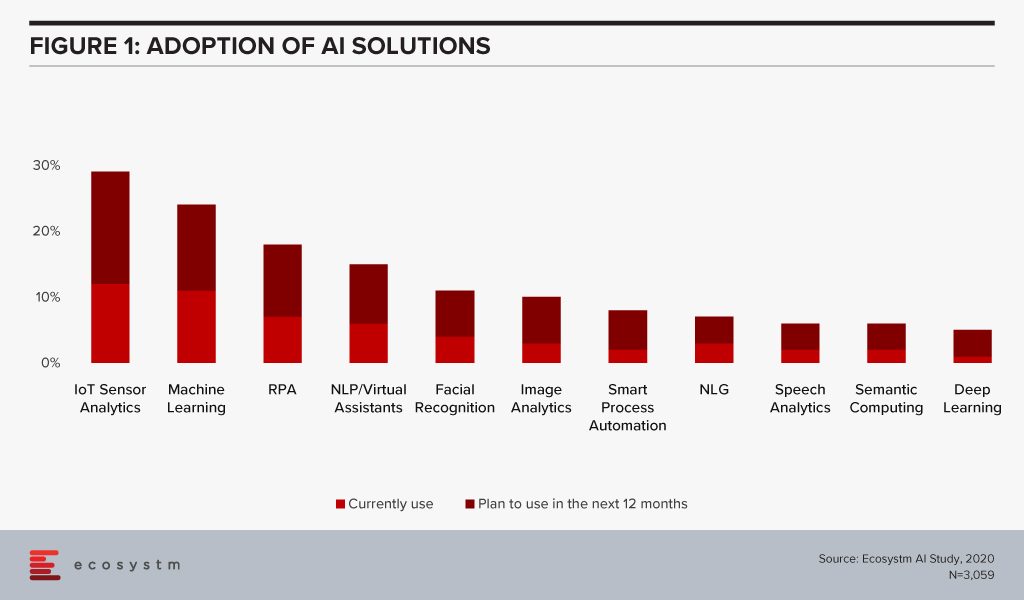
This is especially true for asset and logistics-driven industries such as Resource & Primary, Energy & Utilities, Manufacturing and Retail. Of the AI solutions, the biggest growth in 2020 will also come from IoT Analytics – with Healthcare and Transportation ramping up their IoT spend. And industries will also look at different ways they can leverage the IoT data for operational efficiency and improved customer experience (CX). For instance, in Transportation, AI can use IoT sensor data from a fleet to help improve time, cost and fuel efficiency – suggesting less congested routes with minimal stops through GPS systems, maintaining speeds with automated speed limiters – and also in predictive fleet maintenance.
IoT sensors are already creating – and will continue to create large amounts of data. As organisations look to AI-enabled IoT devices, there will be a shift from one-way transactions (i.e. collecting and analysing data) to bi-directional transactions (i.e. sensing and responding). Eventually, IoT as a separate technology will cease to exist and will become subsumed by AI.
Cloud
AI is changing the way organisations need to store, process and analyse the data to derive useful insights and decision-making practices. This is pushing the adoption of cloud, even in the most conservative organisations. Cloud is no longer only required for infrastructure and back-up – but actually improving business processes, by enabling real-time data and systems access.
Over the next decades, IoT devices will grow exponentially. Today, data is already going into the cloud and data centres on a real-time basis from sensors and automated devices. However, as these devices become bi-directional, decisions will need to be made in real-time as well. This has required cloud environments to evolve as the current cloud environments are unable to support this. Edge Computing will be essential in this intelligent and automated world. Tech vendors are building on their edge solutions and tech buyers are increasingly getting interested in the Edge allowing better decision-making through machine learning and AI. Not only will AI drive cloud adoption, but it will also drive cloud providers to evolve their offerings.
The global Ecosystm AI study finds that four of the top five vendors that organisations are using for their AI solutions (across data mining, computer vision, speech recognition and synthesis, and automation solutions) today, are also leading cloud platform providers (Figure 2).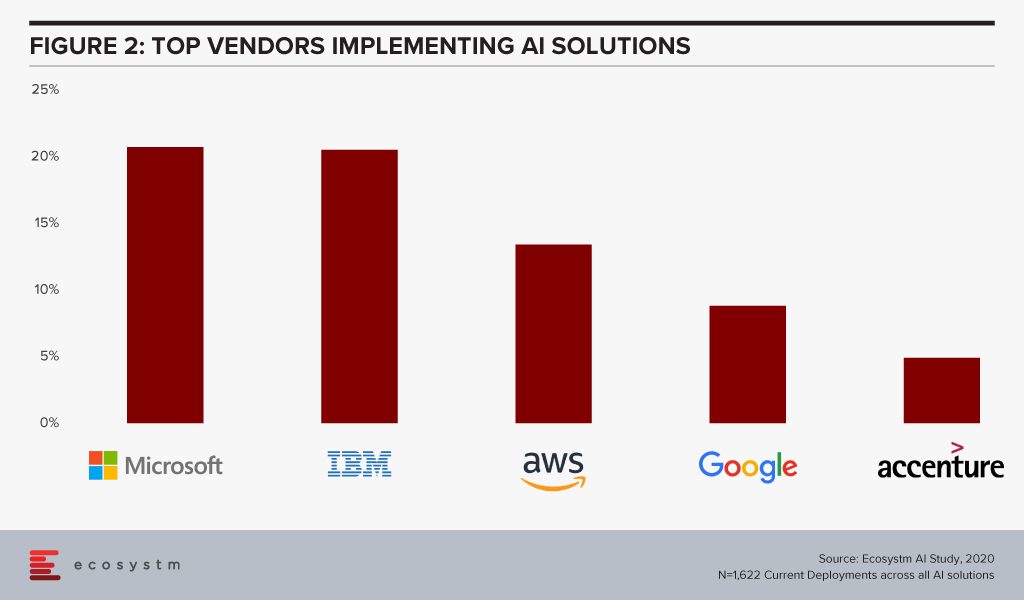
The fact that intelligent solutions are often composed of multiple AI algorithms gives the major cloud platforms an edge – if they reside on the same cloud environment, they are more likely to work seamlessly and without much integration or security issues. Cloud platform providers are also working hard on their AI capabilities.
Cybersecurity & AI
The technology area that is getting impacted by AI most is arguably Cybersecurity. Security Teams are both struggling with cybersecurity initiatives as a result of AI projects – and at the same time are being empowered by AI to provide more secure solutions for their organisations.
The global Ecosystm Cybersecurity study finds that one of the key drivers that is forcing Security Teams to keep an eye on their cybersecurity measures is the organisations’ needs to handle security requirements for their Digital Transformation (DX) projects involving AI and IoT deployments (Figure 3).
While AI deployments keep challenging Security Teams, AI is also helping cybersecurity professionals. Many businesses and industries are increasingly leveraging AI in their Security Operations (SecOps) solutions. AI analyses the inflow and outflow of data in a system and analyses threats based on the learnings. The trained AI systems and algorithms help businesses to curate and fight thousands of daily breaches, unsafe codes and enable proactive security and quick incident response. As organisations focus their attention on Data Security, SecOps & Incident Response and Threat Analysis & Intelligence, they will evaluate solutions with embedded AI.
AI and the Experience Economy
AI has an immense role to play in improving CX and employee experience (EX) by giving access to real-time data and bringing better decision-making capabilities.
Enterprise mobility was a key area of focus when smartphones were introduced to the modern workplace. Since then enterprise mobility has evolved as business-as-usual for IT Teams. However, with the introduction of AI, organisations are being forced to re-evaluate and revamp their enterprise mobility solutions. As an example, it has made mobile app testing easier for tech teams. Mobile automation will help automate testing of a mobile app – across operating systems (Figure 4). While more organisations tend to outsource their app development functions today, mobile automation reduces the testing time cycle, allowing faster app deployments – both for internal apps (increasing employee productivity and agility) and for consumer apps (improving CX).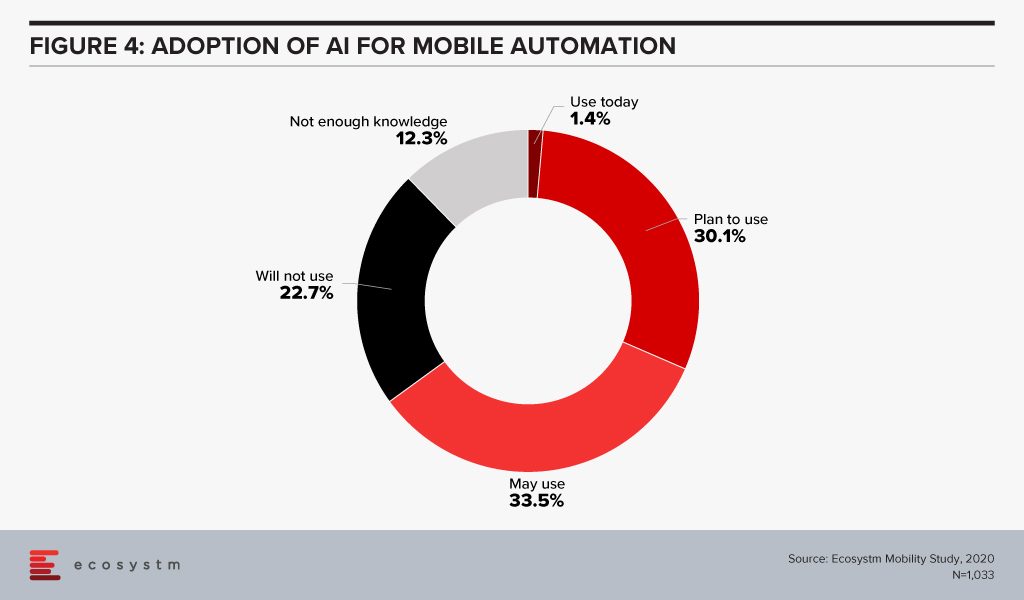
CX Teams within organisations are especially evaluating AI technologies. Visual and voice engagement technologies such as NLP, virtual assistants and chatbots enable efficient services, real-time delivery and better customer engagement. AI also allows organisations to offer personalised services to customers providing spot offers, self-service solutions and custom recommendations. Customer centres are re-evaluating their solutions to incorporate more AI-based solutions (Figure 5).
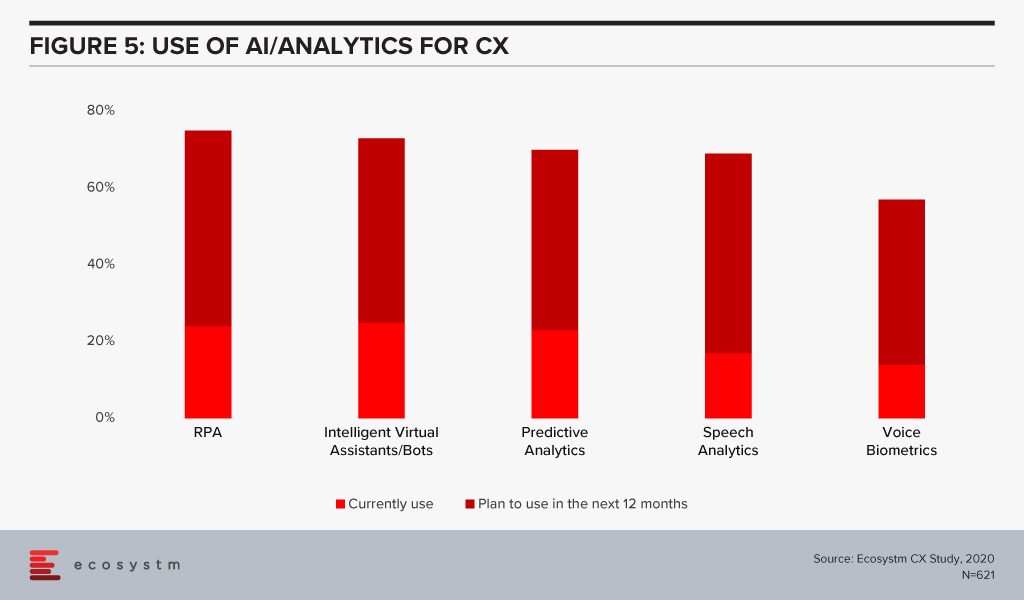
The buzz around AI is forcing tech teams to evaluate how AI can be leveraged in their enterprise solutions and at enabling technologies that will make AI adoption seamless. Has your organisation started re-evaluating other tech areas because of your AI requirements? Let us know in the comments below.

In the Top 5 Customer Experience Trends for 2020 Ecosystm Principal Advisors, Tim Sheedy and Audrey William say that emerging Asia will catch up with the mature economies of the world in their customer obsession. Have emerging economies really embraced Customer Experience (CX) fully or are they just responding to the hype? Do consumers really care about how they connect with brands or do organisations think product offerings is the main differentiator? The business priorities of global organisations reveal that there is a universal focus on improving CX (Figure 1). It is the top business priority across emerging and mature economies, though mature economies are still ahead in their customer focus. Organisations in emerging economies prioritise revenue growth and improving Employee Experience (EX) more than those in mature economies.

Delivering Better CX – The Challenges
Whether these organisations can actually fulfill their CX goals, depends on what their key challenges are. In the end, what consumers want is a consistent CX – across multiple channels and touchpoints. Organisations in emerging economies seem to find it more challenging to drive a more consistent CX (Figure 2). Information siloes are a challenge across all organisations. But organisations in mature economies cite training of their agents as their biggest challenge.
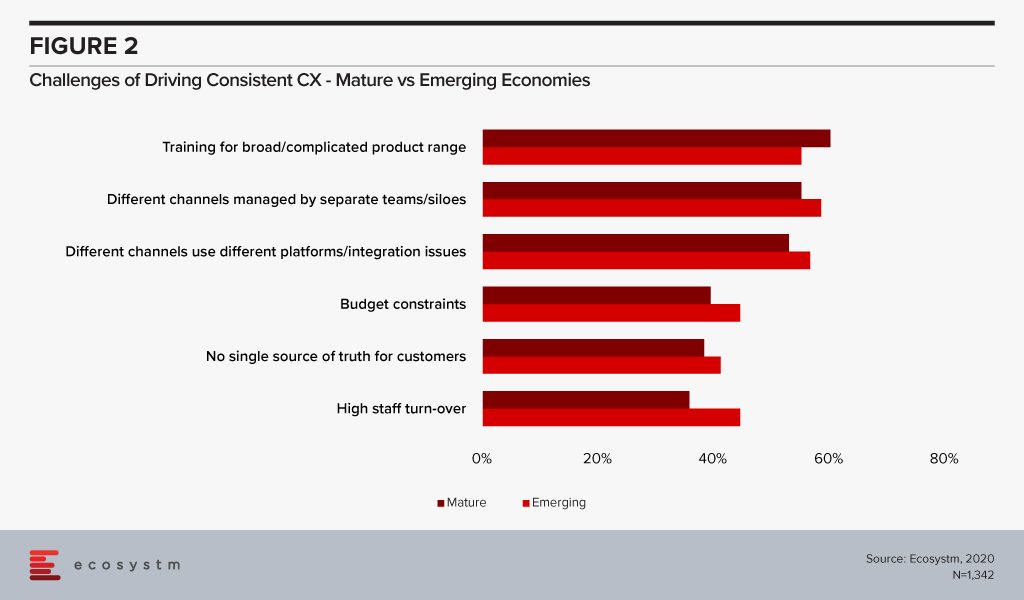
A desire to improve CX must be backed with both vision and budget. The vision should be for the entire organisation to have a single source of truth – not just for the employees – but also a common source of truth that is accessible easily and consistently by customers, across multiple channels. Without this, customer self-service measures will be inadequate. Increasingly customers will want to engage with brands when they want to (very often beyond working hours), how they want to (avoid lengthy voice calls) and where they want to (web and mobile apps). Interoperability of enterprise systems and a robust knowledge base are important factors.
How do Organisations Improve Service Delivery?
If we compare the top CX measures by organisations in mature and emerging economies, we notice a clear difference in priority. In mature economies, organisations appear to have a clear roadmap. They focus on the customers first; followed by empowering the staff to perform their jobs better; invest in technology that will enable both; work on process optimisation; and finally set KPIs and metrics to evaluate the efficacy of the CX measures in place. Also, what they are increasingly doing is setting CX KPIs across the entire organisation – involving all stakeholders. A customer-focused business is one where everything is second to the customers and that should be built firmly into the organisational culture.
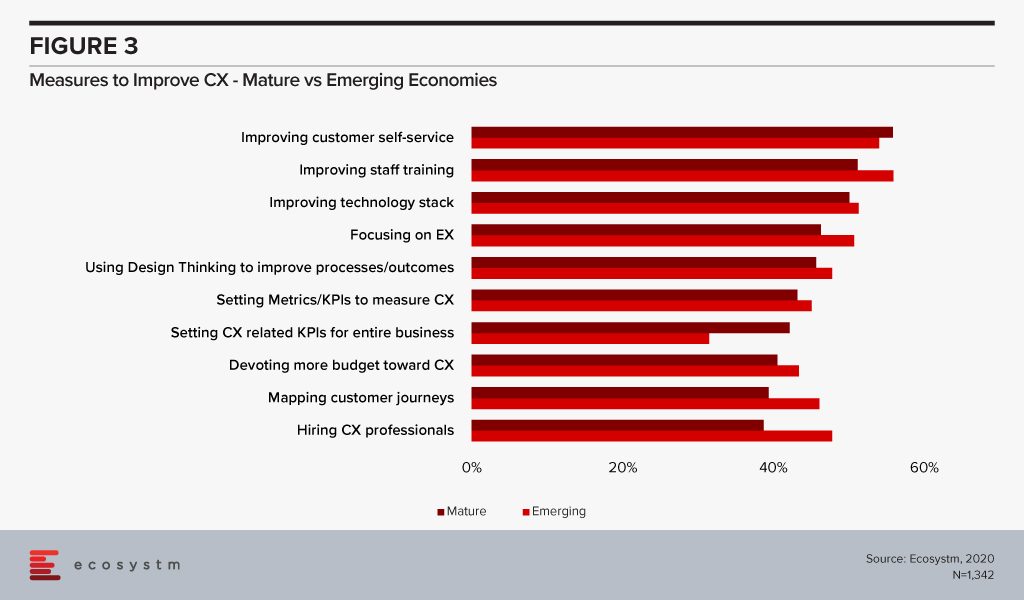
In emerging economies, organisations do not appear to follow a clear roadmap in their CX measures. While self-service is an important aspect of their CX programs, they are more tied down by improving their customer service staff capabilities. They are more challenged by high staff turnover (Figure 2) and appear to be focused on their employees in multiple ways – hiring experts, improving EX and investing in staff training. What they do far less than their counterparts from mature economies is setting organisation-wide CX KPIs.
Web apps are still the most important self-service CX touchpoint, followed by mobile apps. However, emerging economies are ahead when it comes to the importance they place on mobile apps for CX. This is reflective of the high mobile penetration in emerging economies, and the propensity to use mobile devices for all transactions – social and business.
We have seen that organisations in mature economies set CX KPIs more consistently. What are the top CX metrics and are there any differences based on the maturity of the economy (Figure 4)?
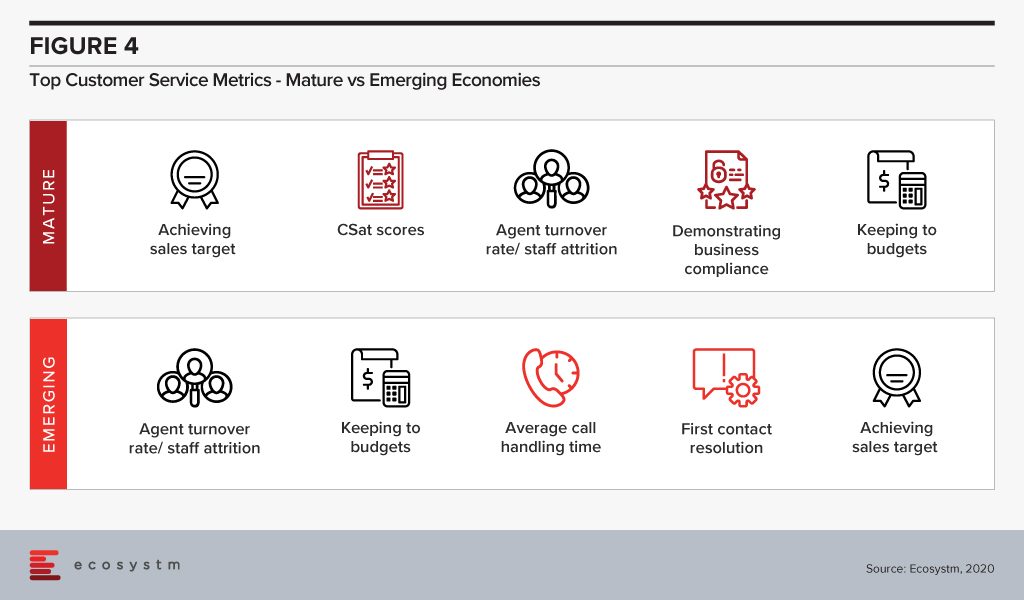
Organisations in emerging economies, continue to be more concerned about attracting and retaining employees. In fact, when asked about their security concerns, these organisations cite agents leaving with data as the key challenge. In mature economies, the key security challenge is improper use of confidential customer data, which can be handled best by continued staff training. In emerging economies, while organisations measure individual areas such as average call duration and first contact resolution, they do not measure customer satisfaction, in its entirety, using CSat scores, for instance. Organisations in mature economies are better at setting KPIs for their CX initiatives and tying them down to outcomes beyond the customer service teams – such as sales and adherence to compliance requirements.
Organisations in mature economies are focused on CX, but to become truly customer-obsessed they need to:
- Evaluate what will enable them to deliver better customer self-service – it is not only about apps, but also about the knowledge base
- Create a clear CX roadmap, focused on the multiple stakeholders and the technology – the steps have to be focused and not ad-hoc
- Inculcate customer obsession across the entire organisation – not just the customer-facing teams
The telecommunications industry has long been an enabler of Digital Transformation (DX) in other industries. Now it is time for the industry to transform in order to survive a challenging market, newer devices and networking capabilities, and evolving customer requirements. While the telecom industry market dynamics can be very local, we will see a widespread technology disruption in the industry as the world becomes globally connected.
Drivers of Transformation in the Telecom Industry
Remaining Competitive
Nokia Bell Labs expects global telecom operators to fall from 10 to 5 and local operators to fall from 800 to 100, between 2020 and 2025. Simultaneously, there are new players entering the market, many leveraging newer technologies and unconventional business models to gain a share of the pie. While previous DX initiatives happened mostly at the periphery (acquiring new companies, establishing disruptive business units), operators are now focusing on transforming the core – cost reduction, improving CX, capturing new opportunities, and creating new partner ecosystems – in order to remain competitive. There is a steady disaggregation in the retail space, driving consolidation in traditional network business models.
“The telecom industry is looking at gradual decline from traditional services and there has been a concerted effort in reducing costs and introducing new digital services,” says Ecosystm Principal Advisor, Shamir Amanullah. “Much of the telecom industry is unfortunately still associated with the “dumb pipe” tag as the over-the-top (OTT) players continue to rake in revenues and generate higher margins, using the telecom infrastructure to provide innovative services.”
Bringing Newer Products to Market
Industries and governments have shifted focus to areas such as smart energy, Industry 4.0, autonomous driving, smart buildings, and remote healthcare, to name a few. In the coming days, most initial commercial deployments will centre around network speed and latency. Technologies like GPON, 5G, Wifi 6, WiGig, Edge computing, and software-defined networking are bringing new capabilities and altering costs.
Ecosystm’s telecommunications and mobility predictions for 2020, discusses how 5G will transform the industry in multiple ways. For example, it will give enterprises the opportunity to incorporate fixed network capabilities natively to their mobility solutions, meaning less customisation of enterprise networking. Talking about the opportunity 5G gives to telecom service providers, Amanullah says, “With theoretical speeds of 20 times of 4G, low latency of 1 millisecond and a million connections per square kilometre, the era of mobile Internet of Everything (IoE) is expected to transform industries including Manufacturing, Healthcare and Transportation. Telecom operators can accelerate and realise their DX, as focus shifts to solutions for not just consumers but for enterprises and governments.”
Changing Customer Profile
Amanullah adds, “Telecom operators can no longer offer “basic” services – they must become customer-obsessed and customer experience (CX) must be at the forefront of their DX goals.” But the real challenge is that their traditional customer base has steadily diverged. On the one hand, their existent retail customers expect better CX – at par with other service providers, such as the banking sector. Building a customer-centric capability is not simple and involves a substantial operational and technological shift.
On the other hand, as they bring newer products to market and change their business models, they are being forced to shift focus away from horizontal technologies and connecting people – to industry solutions and connecting machines. As their business becomes more solution-based, they are being forced to address their offerings at new buying centres, beyond IT infrastructure and Facilities. Their new customer base within organisations wants to talk about a variety of managed services such as VoIP, IoT, Edge computing, AI and automation.
The global Ecosystm AI study reveals the top priorities for telecom service providers, focused on adopting emerging technologies (Figure 1). It is very clear that the top priorities are driving customer loyalty (through better coverage, smart billing and competitive pricing) and process optimisation (including asset maintenance).

Technology as an Enabler of Telecom Transformation
Several emerging technologies are being used internally by telecom service providers as they look towards DX to remain competitive. They are transforming both asset and customer management in the telecom industry.
IoT & AI
Telecom infrastructure includes expensive equipment, towers and data centres, and providers are embedding IoT devices to monitor and maintain the equipment while ensuring minimal downtime. The generators, meters, towers are being fitted with IoT sensors for remote asset management and predictive maintenance, which has cost as well as customer service benefits. AI is also unlocking advanced network traffic optimisation capabilities to extend network coverage intelligently, and dynamically distribute frequencies across users to improve network experience.
Chatbots and virtual assistants are used by operators to improve customer service and assist customers with equipment set-up, troubleshooting and maintenance. These AI investments see tremendous improvement in customer satisfaction. This also has an impact on employee experience (EX) as these automation tools free workforce from repetitive tasks and they be deployed to more advanced tasks.
Telecom providers have access to large volumes of customer data that can help them predict customer usage patterns. This helps them in price optimisation and last-minute deals, giving them a competitive edge. More data is being collected and used as several operators provide location-based services and offerings.
In the end, the IoT data and the AI/Analytics solutions are enabling telecom service providers to improve products and solutions and offer their customers the innovation that they want. For instance, Vodafone partnered with BMW to incorporate an in-built SIM that enables vehicle tracking and provides theft protection. In case of emergencies, alerts can also be sent to emergency services and contacts. AT&T designed a fraud detection application to look for patterns and detect suspected fraud, spam and robocalls. The system looks for multiple short-duration calls from a single source to numbers on the ‘Do Not Call’ registry. This enables them to block calls and prevent scammers, telemarketers and identity theft issues.
Cybersecurity
Talking about the significance of increasing investments in cybersecurity solutions by telecom service providers, Amanullah says, “Telecom operators have large customer databases and provide a range of services which gives criminals a great incentive to steal identity and payment information, damage websites and cause loss of reputation. They have to ramp up their investment in cybersecurity technology, processes and people. A telecom operator’s compromised security can have country-wide, and even global consequences. As networks become more complex with numerous partnerships, there is a need for strategic planning and implementation of security, with clear accountability defined for each party.”
One major threat to the users is the attack on infrastructure or network equipment, such as routers or DDoS attacks through communication lines. Once the equipment has been compromised, hackers can use it to steal data, launch other anonymous attacks, store exfiltrated data or access expensive services such as international phone calls. To avoid security breaches, telecom companies are enhancing cybersecurity in such devices. However, what has become even more important for the telecom providers is to actually let their consumers know the security features they have in place and incorporate it into their go-to-market messaging. Comcast introduced an advanced router to monitor connected devices, inform security threats and block online threats to provide automatic seamless protection to connected devices.
Blockchain
Blockchain can bring tremendous benefits to the telecom industry, according to Amanullah. “It will undeniably increase security, transparency and reduce fraud in areas including billing and roaming services, and in simply knowing your customer better. With possibilities of 5G, IoT and Edge computing, more and more devices are on the network – and identity and security are critical. Newer business models are expected, including those provided for by 5G network slicing, which involves articulation in the OSS and BSS.”
Blockchain will be increasingly used for supply chain and SLA management. Tencent and China Unicom launched an eSIM card which implements new identity authentication standards. The blockchain-based authentication system will be used in consumer electronics, vehicles, connected devices and smart city applications.
Adoption of emerging technologies for DX may well be the key to survival for many telecom operators, over the next few years.



